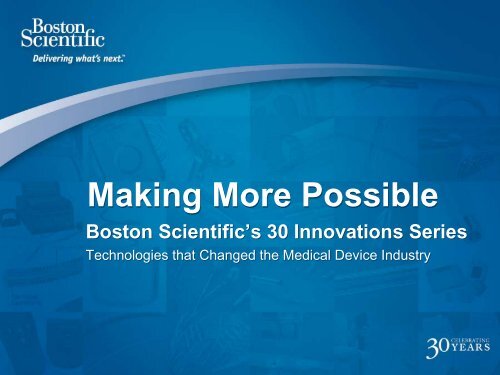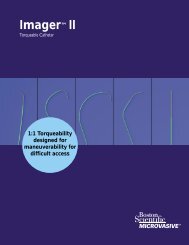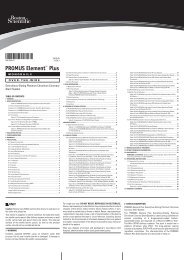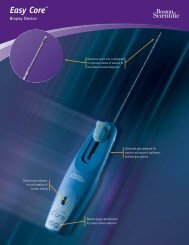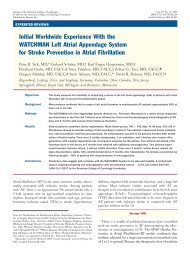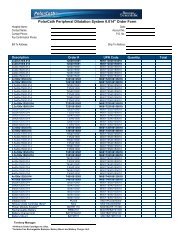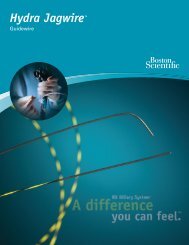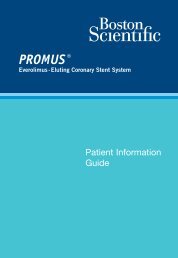Making More Possible - Boston Scientific
Making More Possible - Boston Scientific
Making More Possible - Boston Scientific
You also want an ePaper? Increase the reach of your titles
YUMPU automatically turns print PDFs into web optimized ePapers that Google loves.
<strong>Making</strong> <strong>More</strong> <strong>Possible</strong><br />
<strong>Boston</strong> <strong>Scientific</strong>’s 30 Innovations Series<br />
Technologies that Changed the Medical Device Industry
<strong>Making</strong> <strong>More</strong> <strong>Possible</strong><br />
To commemorate <strong>Boston</strong> <strong>Scientific</strong>’s 30th Anniversary, we are pleased to present the “30 Innovations Series.” This series<br />
highlights the Company’s most groundbreaking products, many of which have helped revolutionize the medical device<br />
industry. Examples of two early products appear below, both conceived and launched by companies eventually acquired by<br />
<strong>Boston</strong> <strong>Scientific</strong>. We hope you enjoy this celebration of our 30-year legacy of innovation as we continue making more<br />
possible for patients and clinicians with technologies that make an impact across a range of therapeutic areas.<br />
Soft-Steerable Catheter System<br />
Introduced in 1969 by Medi-Tech (later part<br />
of <strong>Boston</strong> <strong>Scientific</strong>’s Peripheral<br />
Interventions business)<br />
The original steerable catheter was a versatile<br />
tool that permitted safe, rapid and minimally<br />
invasive access to remote areas of the body<br />
for a variety of diagnostic and therapeutic<br />
procedures. The multi-functional platform<br />
inspired a wide range of physician use,<br />
although its greatest success lay with<br />
interventional radiologists, who used it to<br />
remove gallstones.<br />
MAXILITH Pacemaker<br />
Introduced in 1972 by Intec/CPI, later<br />
Guidant (now part of <strong>Boston</strong> <strong>Scientific</strong>’s<br />
Cardiac Rhythm Management business)<br />
MAXILITH was the first lithium-iodine battery<br />
powered pacemaker, a device used to restore<br />
natural pacing in a heart that would otherwise<br />
beat too slowly. The innovative battery allowed<br />
the device to quadruple the typical longevity of<br />
a pacemaker, increasing the amount of time<br />
between replacements out to five years.
# 1 Peripheral Dilatation balloon<br />
Introduced in 1979 by Medi-Tech*<br />
* Later part of <strong>Boston</strong> <strong>Scientific</strong>’s Peripheral Interventions business<br />
The original Medi-Tech peripheral dilatation<br />
angioplasty balloon was made of polyethylene,<br />
which offered performance advantages over<br />
competitor’s vinyl balloons by being stronger<br />
and less compliant. The polyethylene balloon<br />
propelled <strong>Boston</strong> <strong>Scientific</strong> to market leadership<br />
in peripheral angioplasty, allowing the Company<br />
to eventually pursue market creation in other<br />
fields, such as gastroenterology, cardiology<br />
and urology.
# 2 Greenfield ® Vena Cava Filter<br />
Introduced in 1980 by Kimray Medical, later Mansfield*<br />
* Now sold by <strong>Boston</strong> <strong>Scientific</strong>’s Peripheral Interventions business<br />
The Greenfield Vena Cava Filter is an<br />
implantable filter used in peripheral intervention<br />
procedures designed to prevent blood clots<br />
from reaching the lungs, otherwise know as<br />
pulmonary embolism. The filter is implanted in<br />
more than 10,000 patients annually who are at<br />
high risk for clotting, especially those receiving<br />
knee and hip-replacement surgery, cancer<br />
patients and trauma victims. Since its<br />
introduction, the Greenfield Filter has been<br />
implanted in more than 600,000 patients.
# 3 Pigtail Ureteral Stent<br />
Introduced in 1981 by Van-Tec*<br />
* Now sold by <strong>Boston</strong> <strong>Scientific</strong>’s Urology/Gynecology business<br />
Pigtail Ureteral Stents were pioneered in the<br />
early 1980s and were some of the first stent<br />
products that employed a guide wire to aid in<br />
delivery. The stents were used to hold open<br />
obstructed ureters (the tube passing from each<br />
kidney to the bladder). The product line was<br />
expanded over time to include dilatation<br />
catheters and stone removal equipment for<br />
the kidneys.
# 4 Segura Basket<br />
Introduced in 1984 by Van-Tec*<br />
* Now sold by <strong>Boston</strong> <strong>Scientific</strong>’s Urology/Gynecology business<br />
Named after inventor Dr. Joseph Segura, the<br />
Segura Basket is a tiny receptacle used in lessinvasive<br />
procedures for retrieving stones from<br />
the kidney without requiring them to pass<br />
painfully through the urinary tract. The baskets<br />
are typically inserted via ureteroscope into the<br />
kidney through the urethra or through a small<br />
incision in the back. <strong>Boston</strong> <strong>Scientific</strong> still sells<br />
versions of the original Segura Baskets today.
# 5 AID-B/BR and VENTAK ® Cardiac Devices<br />
Introduced by Intec/CPI, later Guidant*<br />
AID-B/BR Automatic Implantable<br />
Defibrillators<br />
Introduced in 1985<br />
The AID-B/BR devices were the world’s<br />
first FDA-approved automatic<br />
implantable defibrillators (AID). They<br />
were the first implantable devices with<br />
adequate energy to terminate<br />
ventricular fibrillation, thus warranting<br />
the term defibrillator.<br />
* Now part of <strong>Boston</strong> <strong>Scientific</strong>’s Cardiac Rhythm Management business<br />
VENTAK ® Implantable Cardioverter<br />
Defibrillators<br />
Introduced in 1988<br />
VENTAK was the first automatic<br />
implantable cardioverter defibrillator<br />
(AICD) device with programmable rate<br />
detection. Initially developed as a<br />
standard energy device, it was launched<br />
two years later as the first<br />
programmable high-energy device.
# 6 Tracker ® Microcatheters<br />
Introduced in 1985 by Target Therapeutics*<br />
* Now sold by <strong>Boston</strong> <strong>Scientific</strong>’s Neurovascular business<br />
The Tracker Microcatheter family ignited the<br />
field of interventional neurovascular procedures,<br />
providing an interventionalist with the ability to<br />
negotiate vascular bends and bifurcations in the<br />
neurovasculature for the first time. This<br />
innovation eventually led to an entire portfolio of<br />
endovascular therapies for the treatment of<br />
intracranial aneurysms, intracranial<br />
atherosclerotic disease (ICAD) and acute<br />
ischemic stroke.
# 7 Radial Jaw ® Biopsy Forceps<br />
Introduced in 1990 by the Endoscopy business<br />
The Radial Jaw Biopsy Forceps were the first<br />
successful single-use forceps designed to<br />
enable collection of large tissue specimens for<br />
accurate diagnosis of suspicious areas in the<br />
digestive tract. Everyday, more than 30,000<br />
endoscopic procedures are performed using the<br />
Radial Jaw Biopsy Forceps product family for<br />
disease diagnosis. Today, the Radial Jaw<br />
Biopsy Forceps device is in its fourth generation<br />
and still holds the leading market share<br />
position.
# 8 WALLSTENT ® and Ultraflex Stents<br />
Introduced in 1990/1991 by the Endoscopy business<br />
The WALLSTENT Endoprosthesis revolutionized the<br />
palliation of patients with esophageal, colonic, duodenal,<br />
biliary and pulmonary tumors. The Ultraflex colonic<br />
and esophageal stent was introduced a year later,<br />
featuring a double-cell design for control, flexibility, wider<br />
diameters and longer lengths providing physicians with<br />
more treatment options. This family of stents quickly<br />
became the standard of care for the palliative treatment<br />
of esophageal and colonic strictures, and are marketleading<br />
examples of our 20-year commitment to<br />
developing and improving endoscopic stent<br />
technologies. Today, the WallFlex ® Metal Stent platform<br />
represents our third generation of stents, designed to<br />
improve performance with a low-profile delivery system,<br />
enhanced flexibility, visibility and deployment control to<br />
help facilitate new treatment options for patients.
# 9 ENDOTAK ® Cardiac Lead<br />
Introduced in 1991 by CPI, later Guidant*<br />
* Now sold by <strong>Boston</strong> <strong>Scientific</strong>’s Cardiac Rhythm Management business<br />
ENDOTAK was the first FDA-approved<br />
transvenous defibrillation lead system. The<br />
innovative leads allowed application of the<br />
AICD to a patient population not suited for<br />
open-chest procedures, as had been required<br />
up to that time. The ENDOTAK leads were<br />
quickly adopted due to the ease of use while<br />
maintaining the same survival statistics, and<br />
they were soon recognized as nearly as<br />
important as the AICD itself.
# 10 Rotablator ® Atherectomy System<br />
Introduced in 1993 by Heart Technologies*<br />
NEED IMAGE<br />
* Now sold by <strong>Boston</strong> <strong>Scientific</strong>’s Interventional Cardiology business<br />
The Rotablator is a high-speed, diamond-tipped drill<br />
used in cases of diffuse coronary artery disease<br />
where angioplasty and surgery are less effective.<br />
The unique device is delivered via catheter to target<br />
lesions where the rotating football-shaped burr<br />
spins at approximately 200,000 revolutions per<br />
minute, sanding away calcified (hardened) plaque<br />
to open clogged arteries.
# 11 EPT-1000 Cardiac Ablation System<br />
Introduced in 1994 by the Electrophysiology business<br />
The EPT-1000 was the first temperaturemonitoring<br />
cardiac ablation system approved by<br />
the FDA. These devices are used to treat<br />
people living with various cardiac arrhythmias -a<br />
condition that afflicts well over two million<br />
Americans -- by delivering radiofrequency (RF)<br />
energy via an ablation catheter to render the<br />
heart’s abnormal sites electrically inactive. Still<br />
a market leader today, the EPT-1000 RF<br />
Systems are used in more than 80 percent of<br />
electrophysiology labs across the United States.
# 12 Guglielmi Detachable Coils (GDC ® )<br />
Introduced in 1995 by Target Therapeutics*<br />
* Now sold by <strong>Boston</strong> <strong>Scientific</strong>’s Neurovascular business<br />
The GDC coil was the first detachable platinum<br />
coil developed for the embolization of<br />
intracranial aneurysms. This technology<br />
revolutionized the endovascular treatment of<br />
brain aneurysms and created an entire medical<br />
specialty. Since its introduction, there have<br />
been more than 1.75 million GDC coils<br />
implanted in patients worldwide.
# 13 Blazer ® Temperature Ablation Catheter<br />
Introduced in 1996 by the Electrophysiology business<br />
The Blazer Temperature Ablation Catheter was<br />
the first in a family of very successful cardiac<br />
ablation products designed to treat common<br />
cardiac arrhythmias such as atrial flutter and<br />
ventricular tachycardia. The Blazer family of<br />
catheters is designed to provide familiar,<br />
accurate, predictable performance, which is<br />
critical to a successful outcome. The Blazer<br />
Catheter set the bar for ablation catheter<br />
performance and has maintained a strong<br />
leadership position in the EP field with more<br />
than 50 percent U.S. market share to this day.
# 14 CRE Balloon Dilator<br />
Introduced in 1998 by the Endoscopy business<br />
The CRE Balloon Dilator was the first “through the<br />
scope” balloon dilator to feature controlled radial<br />
expansion to three distinct diameters at three<br />
separate pressures in a single balloon. The<br />
balloon’s rounded shoulders facilitate visualization<br />
of the stricture during the dilation procedure. CRE<br />
Balloons are still used extensively today to dilate<br />
strictures in the esophagus, colon, and<br />
gastrointestinal tract caused by cancers and other<br />
life-threatening conditions.
# 15 Maverick ® PTCA Balloon Catheter<br />
Introduced in 2000 by the Interventional Cardiology business<br />
The Maverick Balloon Catheters are used in<br />
angioplasty procedures to dilate narrowed<br />
coronary arteries and/or to expand a stent to<br />
improve blood flow. The Maverick family of<br />
balloon catheters offered innovative features to<br />
improve performance and physician ease of<br />
use, and today Maverick remains an industryleading<br />
coronary balloon platform.
# 16 Synchro ® Guidewires<br />
Introduced in 2001 by the Neurovascular business<br />
The Synchro Guidewire family represented an<br />
evolution in torque transmission for<br />
neurovascular guidewires. For many<br />
physicians, this innovation was essential to<br />
successfully navigate the tortuous anatomy of<br />
the intracranial vasculature. The revolutionary<br />
design of the Synchro Guidewires enabled<br />
physicians to efficiently reach the target area<br />
and deliver therapy.
# 17 Cutting Balloon Monorail Device<br />
Introduced in 2002 by the Interventional Cardiology business<br />
The Cutting Balloon Monorail Device is used in<br />
coronary atherotomy procedures to treat<br />
complex lesions that are often resistant to<br />
conventional balloon angioplasty. The device<br />
features tiny, longitudinally mounted<br />
microsurgical blades (atherotomes) mounted to<br />
the balloon surface. As the balloon is expanded,<br />
the atherotomes score the lesions with<br />
incisions, allowing the balloon to dilate the<br />
vessel with less pressure. The device's<br />
proprietary fold mechanism shields the blades<br />
and protects the vessel wall as the catheter is<br />
passed to and from the treatment site.
# 18 CONTAK ® CD<br />
Introduced in 2002 by Guidant*<br />
* Now sold by <strong>Boston</strong> <strong>Scientific</strong>’s Cardiac Rhythm Management business<br />
CONTAK CD was the first FDA-approved<br />
cardiac resynchronization therapy defibrillator<br />
(CRT-D). These devices are designed for the<br />
treatment of heart failure, a medical condition in<br />
which the heart is unable to pump enough<br />
blood. At the time, estimates indicated that the<br />
condition affected more than 5 million people in<br />
the United States and 6.5 million in Europe.
# 19 Neuroform ® Microdelivery Stent System<br />
Introduced in 2002 by the Neurovascular business<br />
The Neuroform Microdelivery Stent System<br />
was the first intracranial stent used to assist in<br />
the treatment of wide-necked aneurysms. Prior<br />
to the introduction of the Neuroform Stent,<br />
the treatment of wide-necked aneurysms<br />
was extremely difficult and rarely treated<br />
via endovascular therapy. With the Neuroform<br />
Stent accurately placed in an intracranial<br />
vessel, a neurointerventionalist can successfully<br />
pack an aneurysm with embolic coils with<br />
increasing levels of success. Since launch,<br />
there have been more than 40,000 Neuroform<br />
Stents successfully implanted worldwide.
# 20 TAXUS ® Express 2 Coronary Stent System<br />
Introduced in 2004 by the Interventional Cardiology business<br />
The TAXUS Express 2 Paclitaxel-Eluting Stent<br />
System was <strong>Boston</strong> <strong>Scientific</strong>’s first drugeluting<br />
coronary stent and it has been called<br />
by many industry experts “the most<br />
successful product launch in medical device<br />
history.” Within its first few weeks after FDA<br />
approval, the TAXUS Express Stent quickly<br />
gained 70 percent market share, and in less<br />
than one year the product reached an<br />
impressive milestone of one million units sold.
# 21 Advantage ® Mid-Urethral Sling System<br />
Introduced in 2004 by the Urology/Gynecology business<br />
The Advantage System is the first in a series of<br />
mid-urethral slings that provide alternative<br />
approaches for the placement of mid-urethral<br />
slings for the treatment of female stress urinary<br />
incontinence. Each with its own delivery<br />
approach, the mid-urethral sling line offers<br />
flexibility for urologists, gynecologists and<br />
urogynecologists to choose an appropriate<br />
procedure based on patient needs.
# 22 Resolution ® Clip<br />
Introduced in 2004 by the Endoscopy business<br />
The Resolution Clip was the first hemoclip<br />
device to provide definitive endoscopic<br />
hemostasis (arrest of bleeding) to patients<br />
impacted by bleeding in the GI tract. It is the<br />
only mechanical clip on the market designed to<br />
open and close up to five times prior to<br />
deployment, enabling a physician to see the<br />
effects of the clip before committing to use.<br />
Resolution Clip is intended for hemostasis,<br />
endoscopic marking, closure, and anchoring<br />
jejunal feeding tubes.
# 23 Precision ® and Precision Plus Spinal Cord<br />
Stimulator systems<br />
Introduced in 2005/2007 by the Neuromodulation business<br />
The Precision Plus Spinal Cord Stimulator<br />
(SCS) system helps chronic pain patients by<br />
delivering electrical impulses to the spinal cord<br />
that mask pain signals to the brain. It is the<br />
world’s first rechargeable SCS device, and the<br />
first and only one that provides a dedicated<br />
power source for each lead contact. The<br />
Precision Plus system is engineered to deliver<br />
superior outcomes by precisely targeting pain<br />
and maintaining therapy over time, in a solution<br />
designed to fit the patient’s lifestyle.
# 24 LATITUDE ® Patient Management System<br />
Introduced in 2005 by Guidant*<br />
* Now sold by <strong>Boston</strong> <strong>Scientific</strong>’s Cardiac<br />
Rhythm Management business<br />
LATITUDE is the industry's most rapidly adopted<br />
wireless remote device management system for<br />
virtually all ICD and CRT-D patients. This remote<br />
monitoring technology enables patients to have their<br />
heart and specific cardiac device status monitored<br />
from the convenience of their home. The system also<br />
detects clinical events between scheduled visits and<br />
sends relevant data directly to a patient’s physician<br />
and primary cardiologist, if appropriate. LATITUDE is<br />
the industry’s first and only system to include optional<br />
heart failure management tools, which include a<br />
Bluetooth-enabled weight scale and blood pressure<br />
monitor that are consistent with the American College<br />
of Cardiology and American Heart Association<br />
guidelines for managing heart failure patients.
# 25 Wingspan ® Stent System with Gateway ® PTA<br />
Balloon Catheter<br />
Introduced in 2005 by the Neurovascular business<br />
The Wingspan Stent System is specifically<br />
designed to treat Intracranial Atherosclerotic<br />
Disease (ICAD). ICAD causes the tortuous and<br />
fragile vessels in the brain to narrow, thus<br />
resulting in restricted blood flow that can lead to<br />
stroke or death. With the use of the Wingspan<br />
Stent System and Gateway Balloon Catheter, a<br />
neurointerventionalist can reopen the vessel<br />
and restore healthy blood flow.
Carotid WALLSTENT<br />
# 26 ® Monorail ® Endoprosthesis and<br />
FilterWire EZ Embolic Protection System<br />
Introduced in 2006/2008* by the Peripheral Interventions business<br />
* The Carotid WALLSTENT was introduced in<br />
2008 and the FilterWire EZ was introduced<br />
in 2006.<br />
The Carotid WALLSTENT and FilterWire EZ are<br />
used together in carotid artery stenting<br />
procedures -- a minimally invasive alternative to<br />
surgery for treating blockages in the carotid<br />
arteries. The Carotid WALLSTENT features a<br />
closed-cell design, engineered for excellent<br />
lesion coverage and angiographic results, while<br />
the FilterWire EZ Embolic Protection System is<br />
designed to capture plaque debris released<br />
during the stenting procedure, preventing it from<br />
traveling to the brain. Before its launch in the<br />
U.S., the Carotid WALLSTENT became the<br />
leading carotid stent in Europe and other<br />
international markets due to excellent patient<br />
outcomes and ease of use in complex anatomy.
# 27 iLab Ultrasound Imaging System<br />
Introduced in 2006 by the Interventional Cardiology business<br />
<strong>Boston</strong> <strong>Scientific</strong> was a pioneer in the<br />
intravascular ultrasound (IVUS) imaging market,<br />
developing its first device in 1989 and becoming<br />
a market leader with successive product<br />
launches. The iLab System was the first of its<br />
kind, allowing direct installation into a cardiac<br />
catheterization lab or radiology suite, enabling<br />
physicians to quickly and easily incorporate<br />
IVUS technology into their daily procedures to<br />
assist with diagnosis within the coronary and<br />
peripheral arteries, and aid in stent placement.
# 28 SpyGlass ® Direct Visualization System<br />
Introduced in 2007 by the Endoscopy business<br />
SpyGlass is the first single-operator<br />
cholangioscopy system designed to provide<br />
direct visualization throughout the entire<br />
pancreatico-biliary system to enable physicians<br />
to diagnose and treat a wide range of diseases,<br />
including pancreatic cancer and stone disease.<br />
The SpyGlass technology is also redefining<br />
patient care by leveraging single-use<br />
technology, providing everyday access to<br />
physicians and potentially offering significant<br />
procedural and clinical advantages over<br />
conventional visualization methods.
# 29 PROMUS ® Coronary Stent System*<br />
Introduced in 2008 by the Interventional Cardiology business<br />
* The PROMUS Stent is a private-labeled XIENCE V ®<br />
Everolimus-Eluting Coronary Stent System manufactured by<br />
Abbott and distributed by <strong>Boston</strong> <strong>Scientific</strong>.<br />
PROMUS is an everolimus-eluting coronary<br />
stent built on a highly deliverable platform.<br />
Shortly after its U.S. launch, PROMUS became<br />
one of the best-selling drug-eluting stents on<br />
the market. It also allowed <strong>Boston</strong> <strong>Scientific</strong> to<br />
become (and remain) the only stent<br />
manufacturer to offer two distinct drug-eluting<br />
stent platforms (paclitaxel and everolimus).
# 30 COGNIS CRT-D and TELIGEN ICD<br />
Introduced in 2008 by Cardiac Rhythm Management<br />
The COGNIS cardiac resynchronization therapy<br />
defibrillator and the TELIGEN implantable<br />
cardioverter defibrillator are the world’s smallest<br />
and thinnest high-energy devices, representing<br />
entirely new platforms to treat heart failure and<br />
sudden cardiac death. Both devices offer<br />
innovative features based on substantial<br />
engineering advances, including extended<br />
battery longevity, self-correcting software and<br />
improved programming technology.
Caution:<br />
Prior to using any <strong>Boston</strong> <strong>Scientific</strong> device, refer to specific product<br />
packaging for complete indications for use, contraindications, warnings,<br />
precautions, potential adverse events and instructions for use.<br />
<strong>Boston</strong> <strong>Scientific</strong> Corporation<br />
One <strong>Boston</strong> <strong>Scientific</strong> Place<br />
Natick, MA 01760-1537<br />
www.bostonscientific.com<br />
© 2009 <strong>Boston</strong> <strong>Scientific</strong> Corporation or its affiliates. All rights reserved.<br />
cc.30innovationsppt.ww.09.09


